Transplanting peonies can be a tricky process, so it’s important to understand the best time to transplant them. This guide covers everything you need to know about when to transplant your peonies, including tips for dealing with mature or overgrown plants.
Additionally, we’ll discuss how weather conditions can affect the process and provide helpful advice on creating an optimal planting site.
By the end of this guide, you’ll be able to confidently transplant any kind of peony with little effort!
When to Transplant Peonies?
The best time to transplant peonies is in the fall when temperatures are cooler and rainfall is higher. This allows the roots of the peony to develop their new home before winter arrives.
Peonies prefer well-draining soil that is rich in organic matter. If your soil doesn’t meet these requirements, you should consider amending it with compost or manure before transplanting your peonies.
In addition to soil type, you should also consider the size of your peony. Mature or overgrown plants can be tricky to transplant and may require special care.
If possible, it’s best to separate any large clumps of roots before attempting to move them. This will make it easier for the plant to establish itself in its new environment. [1]
How to Divide Peonies
If you’re transplanting mature or overly dense peonies, it’s important to divide the roots before moving them. This is because peonies are typically planted in large clumps of roots which can be difficult and potentially damaging to remove from their original location.
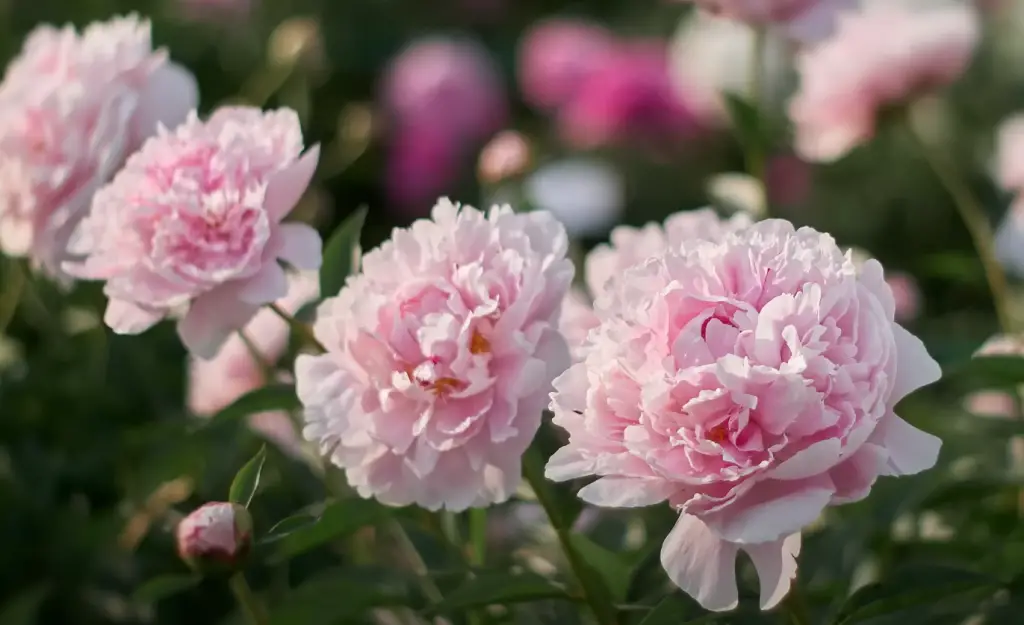
To safely divide a cluster of peonies, start by cutting off any dead or dying foliage. Once this is complete, use a garden fork or spade to loosen the dirt around the roots and then gently remove them from the ground.
Next, use your hands or a sharp knife to separate the clump of roots into individual plants.
If you’re having difficulty separating them, consider soaking them in water overnight which will help soften up any stubborn root clusters. Once each peony is divided, it’s time to move them into their new home.
Where to Transplant Peonies?
When deciding on a location to transplant your peonies, consider the climate and soil type of the area. Peonies typically thrive in sunny locations with well-draining soil that is rich in organic matter.
If your soil doesn’t meet these requirements, amend it by adding compost or manure before planting. Additionally, try to avoid areas that are prone to flooding as this can cause the plants to rot.
Once you’ve located an ideal area, dig a hole that is twice as wide and deep as the root ball of your peony. Be sure to leave enough space between each plant so they have room to grow.
Once the holes are complete, place each peony in its respective hole and gently backfill with soil. Using your hands, lightly tamp down the dirt to ensure the roots are firmly in place and then water each plant thoroughly.
Caring for New Peony Transplants
When caring for newly transplanted peonies, it’s important to monitor the soil moisture levels and adjust accordingly. Peonies prefer moist soils that are never soggy or waterlogged.
Additionally, try to avoid overfertilizing your plants as this can lead to root burn and nutrient deficiencies.
This will also help retain moisture and regulate soil temperature. With these simple tips, you can rest assured that your peonies will thrive in their new home! [1]
Instructions
Identify a New Site
If you’re looking to transplant your peonies in the spring, it’s important to find a new location with similar soil and climate conditions. When searching for a suitable area, try to find one that is sunny and well-draining. Additionally, make sure there are no overly wet areas as this can cause your plants to rot.
Prepare the Soil
Once you have identified a new location for your peonies, it’s time to start preparing the soil.
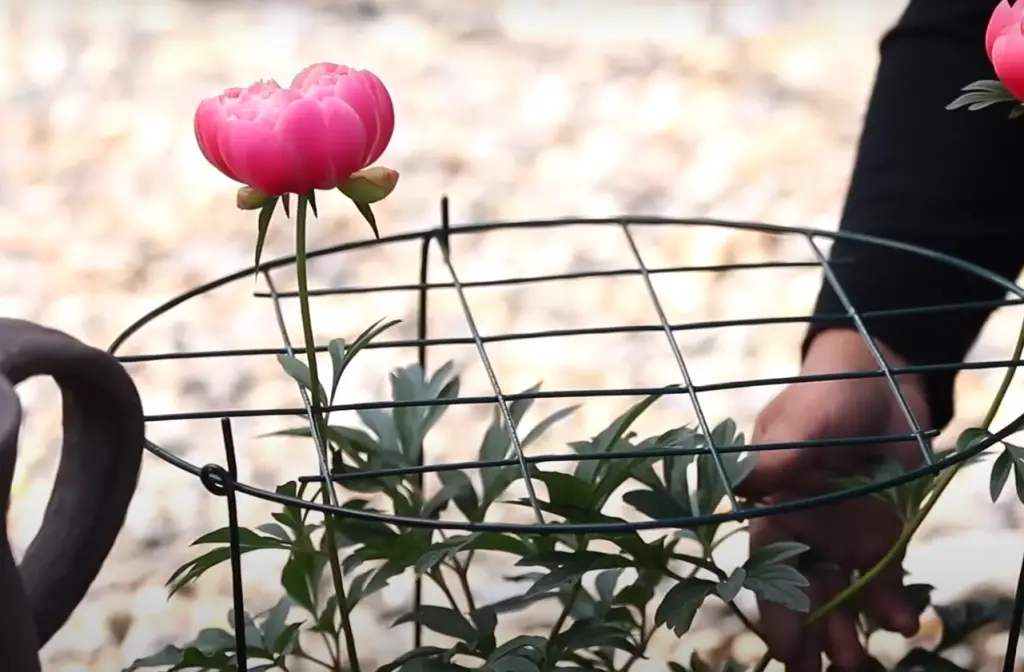
If necessary, amend the soil with organic matter such as compost or manure to ensure it is well-draining and nutrient-rich. This will help your plants thrive in their new home!
Dig Up the Peony
When it’s time to dig up your existing peony, use a garden fork or spade to gently loosen the soil around the roots.
Additionally, consider soaking them in water overnight which will help soften any stubborn root clusters.
Identify the Eyes
Peony plants can have up to 15 eyes or buds at the base of each root. Identifying these is important as they will determine where your plant will flower and grow.
When transplanting, try your best to keep the orientation of the eyes intact so that your peonies can blossom successfully in their new home.
Plant the Peony
Once you’ve identified the eyes, it’s time to plant your peonies in their new location. Dig a hole that is twice as wide and deep as the root ball of your peony and place each plant in its respective hole. Gently backfill with soil, lightly tamp down the dirt using your hands and water thoroughly. [2]
FAQ
Do peonies tolerate transplanting?
Yes, peonies can tolerate transplanting as long as it is done properly. When transplanting with care, they will grow and bloom successfully in their new location!
How often should I water newly transplanted peonies?
Newly transplanted peonies should be watered at least once a week during the summer months. Make sure not to overwater, however, as too much water can lead to root rot and nutrient deficiencies.
What type of soil do peonies prefer?
Peonies typically prefer well-draining soil that is rich in organic matter such as compost or manure. If your soil doesn’t meet these requirements, consider amending it before transplanting your peonies.
Do peonies need mulch?
Yes, peonies can benefit from a 2-3 inch layer of organic material such as bark or straw. This will protect the plants from harsh temperatures and weeds while also helping to retain moisture and regulate soil temperature.
Can you transplant peonies in the spring?
Yes, spring is an ideal time to transplant peonies as the soil is soft and easy to work with. Additionally, young plants will find it easier to establish themselves in their new environment!
Do peonies like sun or shade?
Peonies typically prefer sunny locations with at least 6 hours of direct light each day. If your area is particularly hot or humid, consider providing some afternoon shade for your plants. Additionally, try to avoid areas that are prone to flooding as this can cause the plants to rot.
Where do peonies grow the best?
Peonies usually grow best in sunny locations with well-draining soil that is rich in organic matter.
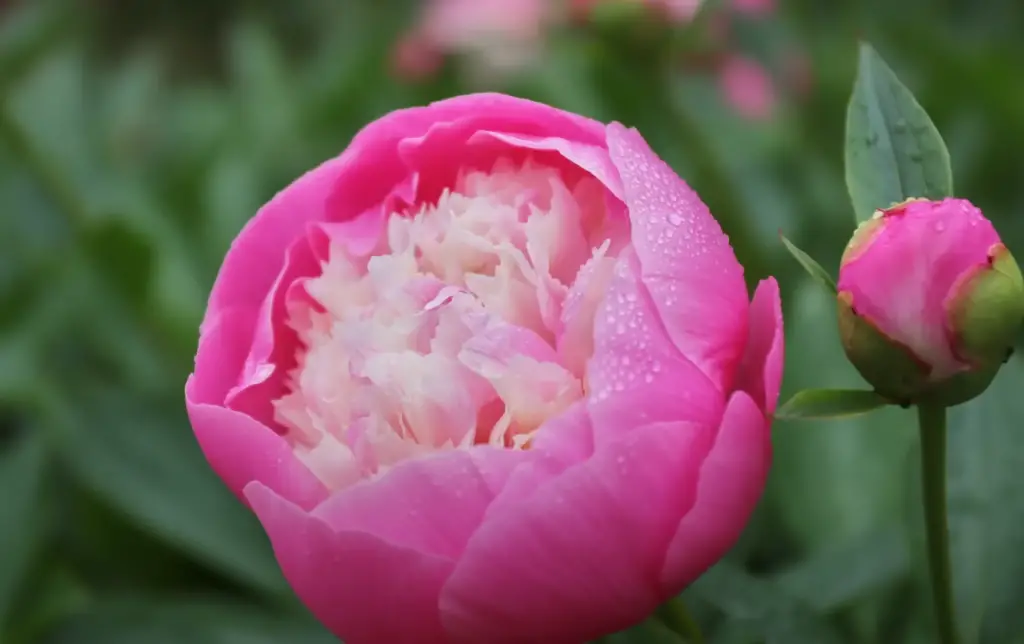
Additionally, try to avoid areas that are prone to flooding as this can cause the roots to rot. With these simple tips, you can rest assured that your peonies will thrive in their new home!
Do I need to stake my newly transplanted peonies?
Yes, it is important to stake newly transplanted peonies as they may topple over in strong winds or heavy rains.
This can be done by using bamboo stakes and tying them securely around the base of the plants. Additionally, consider pruning away any dead or diseased branches for optimal growth and health.
Can peonies get too much sun?
Yes, peonies can get too much sun which can lead to sunburn or wilting. If your area is particularly hot and humid, consider providing some afternoon shade for your plants. Additionally, never let the soil dry out completely as this can be damaging to their roots.
What should I avoid when transplanting peonies?
When transplanting peonies, try to avoid over watering or overfertilizing your plants as this can lead to root burn and nutrient deficiencies.
Additionally, never let the soil dry out completely as this can be damaging to their roots. If possible, amend your soil with organic matter such as compost or manure before transplanting to ensure it is nutrient-rich and well-draining.
What type of mulch should I use for peonies?
Organic material such as bark or straw is the best type of mulch for peonies. Make sure to spread a 2-3 inch layer around the plants and avoid piling it up against their stems as this can cause them to rot.
What is the best time to transplant peonies?
Spring is usually the ideal time for transplanting as the soil is soft and easy to work with. Additionally, young plants will find it easier to establish themselves in their new environment! However, if you’re dealing with mature or overgrown plants, fall can also be a good time to transplant.
What should I do if my peonies don’t bloom?
If your peonies are not blooming as expected, there could be a few different causes. The first step is to check that you have planted them in an area with at least 6 hours of direct sunlight each day.
Additionally, make sure the soil is well-draining and amend it with organic matter such as compost or manure if necessary.
Finally, ensure that your plants are getting enough water and do not overwater. If all of these steps fail, consider consulting a professional gardener for more advice!
What should I do if my peonies are getting too tall?
If your peonies are getting too tall, consider cutting them back by up to two-thirds of their height. This will encourage bushier growth and help to keep the plants in check. Additionally, consider staking your plants as this can help keep them upright while also providing extra support.
How should I care for transplanted peonies?
Caring for transplanted peonies is not difficult, but there are a few key things to remember. Make sure to water your plants at least once a week and provide them with some afternoon shade if necessary.
Additionally, consider mulching your plants with organic material such as bark or straw and amend the soil with compost or manure if needed.
Finally, stake your plants as this can help keep them upright while also providing extra support. With these simple steps, you can ensure that your peonies will thrive in their new home!
Do I need to fertilise my newly transplanted peonies?
Yes, fertilising newly transplanted peonies is important for helping them establish themselves in their new environment.
Choose a fertiliser that is specifically formulated for peonies and make sure not to overfeed your plants as this can cause root burn and nutrient deficiencies.
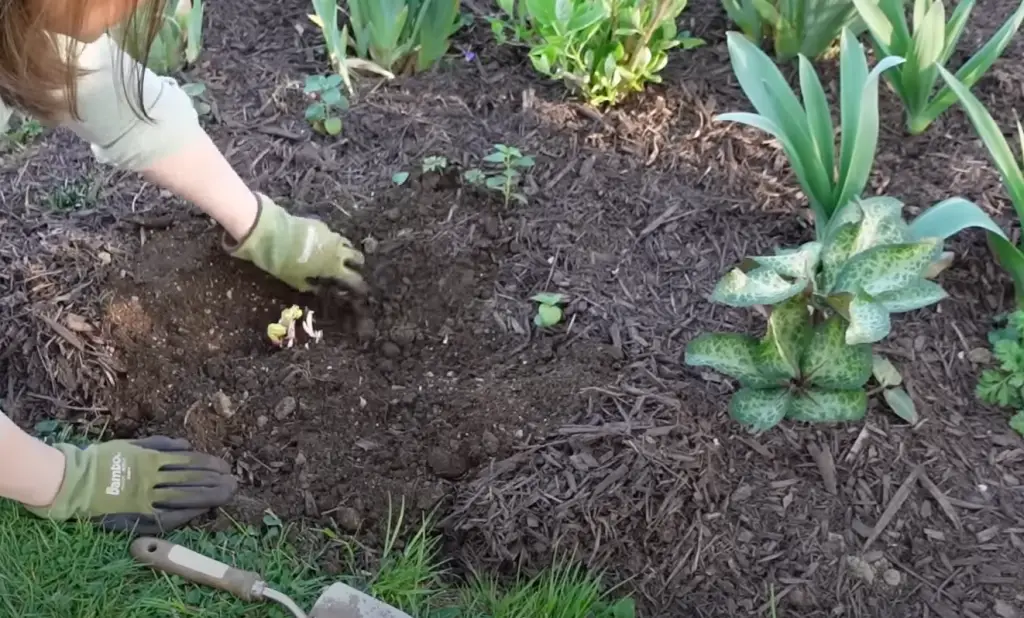
Additionally, consider adding some compost or manure to the soil before applying the fertiliser for extra nutrients.
Does transplanting peonies hurt them?
Transplanting peonies does not have to hurt the plants, as long as it is done correctly. Make sure to carefully dig up the entire root system and avoid breaking or damaging any of the roots.
Additionally, consider providing some shade for your transplanted peonies until they become established and begin producing new growth.
Do peonies need frequent replanting?
No, peonies typically do not require frequent replanting. However, if your plants become overcrowded it is a good idea to divide them and replant in new locations. Additionally, consider moving your peonies to a sunnier location or one with better soil drainage if necessary.
Do I need to prune my peonies?
Yes, it is important to prune your peonies annually for optimal health and growth. Make sure to remove any dead or diseased branches as well as cutting back the stems by up to two-thirds of their height.
Additionally, consider staking your plants if necessary in order to help keep them upright.
Does mulching help protect peonies from winter?
Yes, mulching your peonies during the winter can be beneficial for protecting them from extreme cold. Make sure to spread a 2-3 inch layer of organic material such as bark or straw around the plants and avoid piling it up against their stems.
Additionally, consider applying an extra layer of mulch in late fall to help insulate the roots. With these simple steps, your peonies will be ready to welcome spring!
Can I transplant my peonies in the summer?
Yes, you can transplant your peonies in the summer as long as you make sure to provide them with plenty of water and some shade for protection. Additionally, consider amending your soil with organic matter such as compost or manure before transplanting to ensure it is nutrient-rich and well-draining.
Do I need to stake newly transplanted peonies?
Yes, staking newly transplanted peonies is important for providing extra support while they are establishing themselves in their new environment. Make sure to use a stake that is at least two feet tall and attach it securely to the stem of your plant.
Additionally, consider adding some organic mulch around the base of your plants as this can help keep them upright.
Does peony transplanting require any specialised tools?
No, peony transplanting does not require any special tools. All you need is a shovel or spade for digging up the root system and an appropriate size container for transporting your plants to their new location.
Additionally, consider using stakes if needed in order to help keep your plants upright while they become established.
Do I need to cover newly transplanted peonies?
No, you do not typically need to cover your newly transplanted peonies. However, providing some shade for a few days can be beneficial while they are adjusting to their new environment.
Additionally, consider mulching the soil around your plants with organic material such as bark or straw in order to help keep moisture levels consistent. With these simple steps, your plants should be able to thrive in their new home!
How often should I water newly transplanted peonies?
Watering newly transplanted peonies is important for helping them establish themselves in their new environment. Make sure to water your plants at least once a week and more frequently in hot weather or during periods of drought.
Additionally, consider using drip irrigation or other methods of delivering water directly to the root system as this can help ensure your plants are getting enough moisture.
How long will it take for transplanted peonies to settle in?
Transplanted peonies typically take a few weeks to a couple of months to fully establish themselves in their new environment.
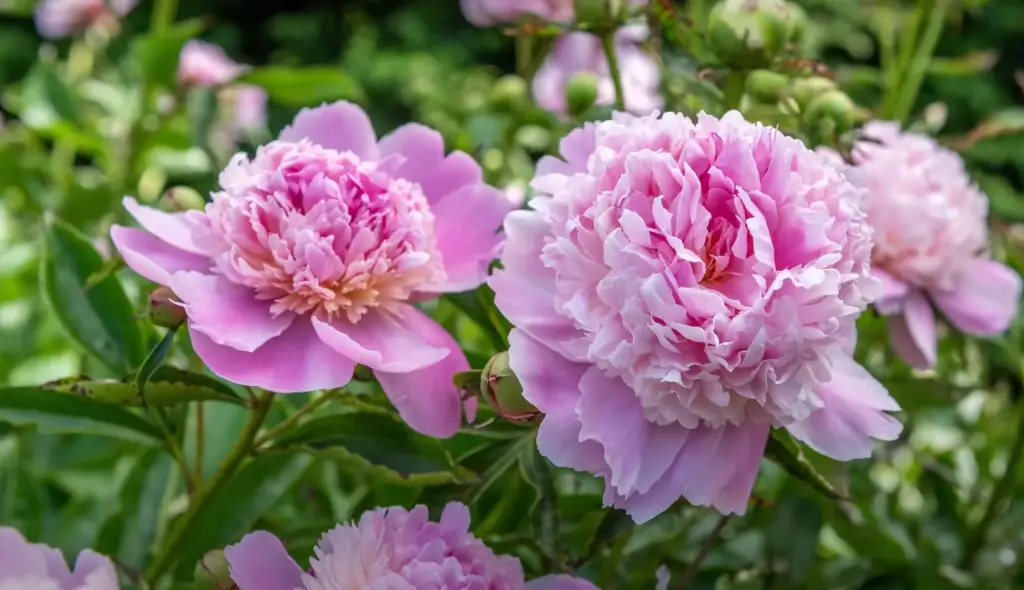
Make sure to provide your plants with the proper care and avoid moving them or disturbing the roots during this time. With some patience, your transplanted peonies should soon be thriving!
How long do peonies live?
Peonies can live for a very long time, up to 50 years or more! Make sure to provide your plants with the proper care and consider dividing them every four to five years if they become overcrowded.
Additionally, try planting your peonies in well-draining soil and using a fertiliser designed specifically for this type of plant in order to ensure they stay healthy and happy for many years to come.
Which types of soil are best for peonies?
Peonies prefer well-draining soils with a neutral pH. Make sure to amend your soil with organic matter such as compost or manure before planting in order to ensure it is nutrient-rich and able to retain moisture.
Additionally, consider adding some mulch around your plants once they become established as this can help keep moisture levels consistent and protect them from extreme temperatures. With the right soil conditions, your peonies should be able to thrive!
What is the best time of year to transplant peonies?
The best time of year to transplant peonies is in fall or early spring, just before their new growth begins. Make sure to prepare your soil with compost or manure and provide plenty of water while your plants are becoming established.
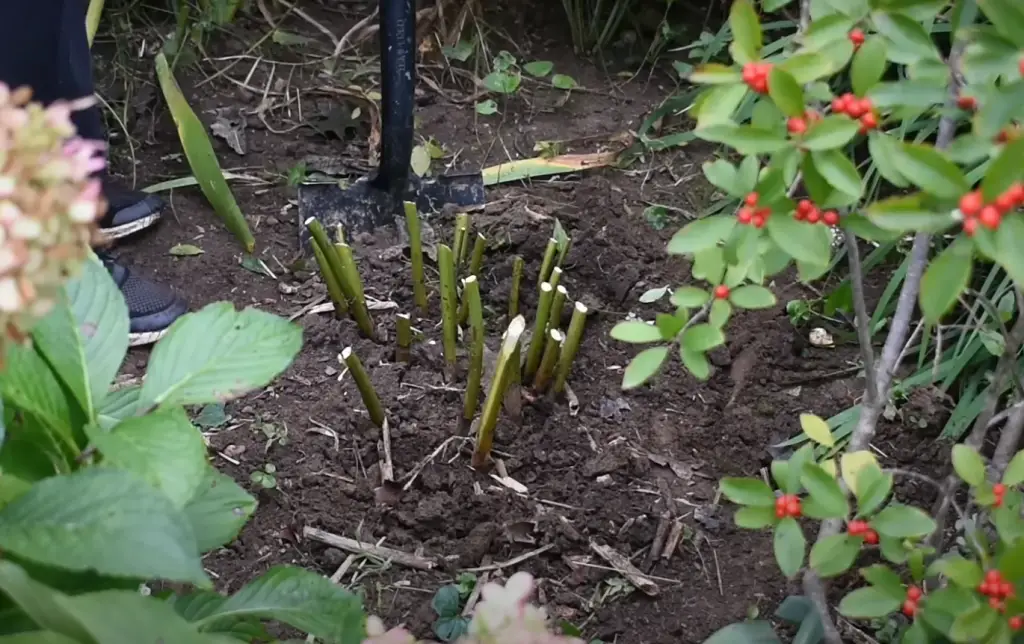
Additionally, consider providing some shade for your peonies until they begin to produce new growth.
Do peonies need lots of sun?
Peonies typically prefer partial shade but can tolerate some full sun if necessary. Make sure to provide your plants with enough light for good blooms, and consider moving them to a sunnier location or one with better soil drainage if necessary.
Additionally, consider adding an extra layer of mulch during the winter in order to help insulate the roots and keep your plants happy.
Useful Video:How To Transplant Peonies
Conclusion
Transplanting peonies can be a great way to get more of these beautiful plants in your garden. Make sure to prepare your soil, provide plenty of water while the plants are settling in, and consider staking them if necessary for extra support.
Additionally, mulching around the base of your peonies during the winter can help protect them from extreme temperatures and keep their roots insulated. With the right care, your transplanted peonies should soon be thriving in their new home!
Now that you know more about when to transplant peonies and what it takes to keep them healthy, don’t forget to share this information with other gardeners and plant lovers! Peonies are a beloved flower and knowing how to properly transplant them can help ensure they stay in our gardens for many years to come. Happy gardening!
References:
- https://www.bhg.com/gardening/flowers/perennials/how-to-transplant-peonies/
- https://www.thespruce.com/how-to-transplant-peonies-4579809





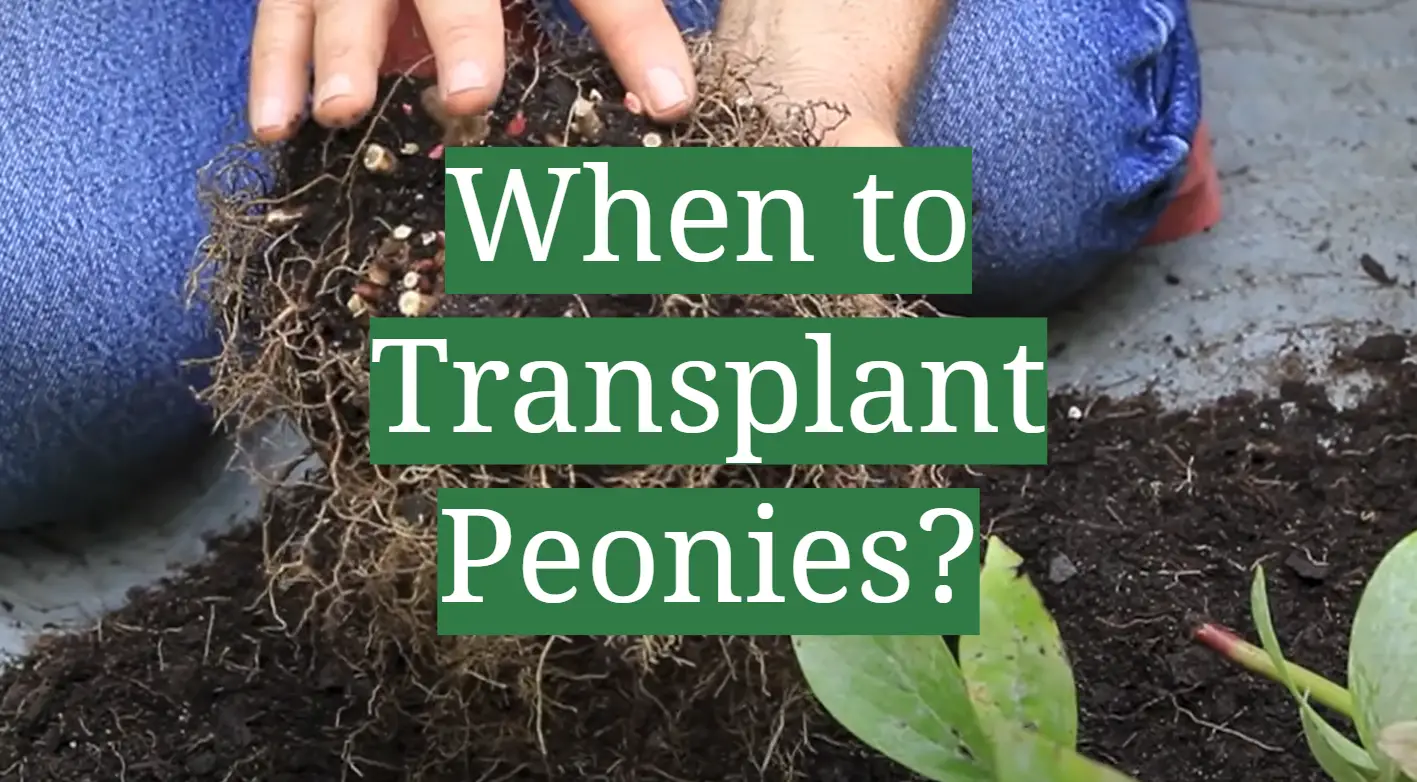




Leave a Reply
View Comments